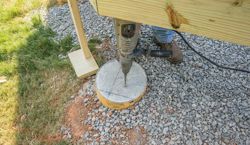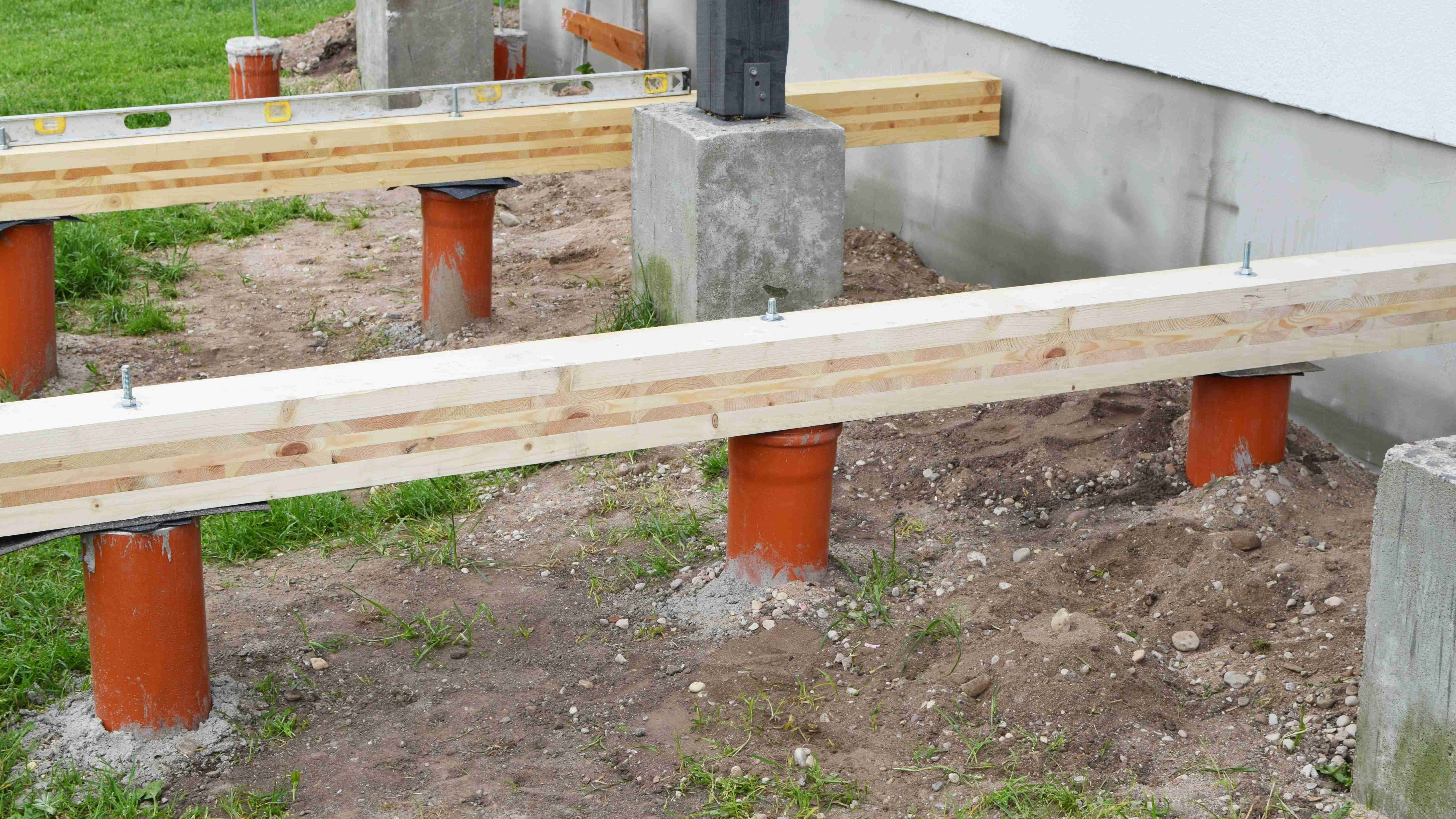Step-by-Step Deck Excellence: Ensuring Security with Correctly Mounted Deck Footings
Step-by-Step Deck Excellence: Ensuring Security with Correctly Mounted Deck Footings
Blog Article
Picking the Right Deck Footings for Stability and Toughness
The longevity and safety of your deck depend heavily on the type of grounds you choose, as they supply the crucial support and security to stand up to the examination of time. In this discussion, we will certainly check out the different types of deck grounds, think about the vital variables to evaluate when making a decision, and dig right into the pros and disadvantages of different choices.
Kinds Of Deck Footings
There are numerous kinds of deck grounds that can be made use of, each offering one-of-a-kind benefits and considerations. One common sort of ground is the concrete pier ground. These grounds contain a cylindrical hole loaded with concrete, which offers a strong structure for the deck messages. Concrete pier footings are fairly easy to install and use excellent stability, making them a popular choice for several deck tasks.
Another type of ground is the helical heap ground. Helical stacks are steel shafts with helical plates attached to them. These footings are set up by screwing them right into the ground, which produces a secure foundation for the deck. Helical pile grounds are optimal for locations with difficult soil problems, as they can be set up in nearly any kind of sort of soil. If needed., they likewise enable for easy adjustment and progressing of the deck.
Conversely, some home builders decide for precast concrete grounds. These footings are constructed from long lasting concrete and can be found in different forms and dimensions to suit different deck styles. Precast concrete footings are convenient to mount and offer a secure base for the deck framework.
Lastly, another option is the post-in-anchor footing system. This kind of footing includes driving a metal support into the ground and affixing it to the deck blog post. It provides versatility in terms of placing the deck posts and appropriates for decks with light-weight structures.
When selecting the right kind of deck ground, it is necessary to consider aspects such as dirt problems, deck tons, and local building codes (Deck Footings). Consulting with an expert service provider or structural designer can aid guarantee the proper footing is selected for a safe and steady deck
Aspects to Consider When Selecting Grounds
When selecting the ideal grounds for a deck, it is important to meticulously think about numerous variables such as soil problems, deck lots, and adherence to regional structure codes. These variables play a considerable role in guaranteeing the security and sturdiness of the deck structure.
Among the primary elements to take into consideration is the dirt problems. The sort of dirt on which the deck will certainly be built establishes the sort of footings called for. Decks built on sandy or loosened dirts might need much deeper grounds to supply ample assistance and protect against settling. On the various other hand, decks developed on clay or large soils may require footings that can fit the dirt's propensity to expand and agreement.
One more crucial variable is the deck load. The weight of the deck, including the products utilized and any type of prospective live tons such as furniture or gatherings, need to be taken into consideration when selecting grounds. The grounds should be designed to bear the weight of the deck and distribute it uniformly to prevent any architectural issues or failures.
Lastly, adherence to regional building codes is vital. Building regulations differ from region to region, and it is vital to follow the specific needs established by the regional authorities. Deck Footings. These codes make certain that the deck is built safely and meets the needed requirements for structural honesty and load-bearing ability
Concrete Footings: Advantages And Disadvantages

Concrete grounds use numerous advantages and disadvantages when used as the foundation for a deck. On the positive side, concrete grounds provide exceptional stability and longevity. Concrete is a rigid and strong material that can support heavy tons and hold up against different climate problems. It likewise has a long lifespan, making it a trusted selection for lasting usage.
An additional advantage of concrete grounds is their versatility. They can be put right into various sizes and shapes to accommodate various deck designs and arrangements. Concrete grounds can be customized to fit the specific needs and demands of the deck framework.
Nevertheless, there are also some disadvantages to using concrete footings. One major drawback is the cost and labor associated with their installment. Concrete footings require excavation and usually need the assistance of heavy machinery. This can boost the total price of the deck task and might call for specialist aid.

Helical Piers Vs. Sonotubes: Which Is Much better?
In taking into consideration the structure alternatives for a deck, the comparison in between helical piers and sonotubes is vital in identifying the premium option. They are twisted into try this site the ground making use of hydraulic equipment, supplying a steady and resilient structure for the deck.
When it involves security and resilience, helical piers have the upper hand. The helical plates on the piers produce a solid grasp with the soil, shifting or protecting against any type of activity of the deck. This is particularly helpful in locations with unpredictable or moving soil problems. Sonotubes, on the various other hand, rely solely on the concrete loading for security, which might not use the very same degree of toughness and resistance.
In terms of installment, helical piers are reasonably less complicated and faster to mount contrasted to sonotubes. The hydraulic equipment used to turn the piers right into the have a peek at these guys ground makes certain a quick and efficient process. Sonotubes, on the other hand, require excavating holes and putting concrete, which can be lengthy and labor-intensive.
Additionally, helical piers are an even more functional alternative. If needed, they can be made use of in various dirt conditions and can be adjusted or enhanced. Sonotubes, on the other hand, may require extra assistance, such as rebar, in particular dirt problems or locations with high lots needs.
Choosing the Right Footings for Your Deck's Measurements
For optimal architectural integrity, it is important to carefully choose the proper grounds that straighten with the dimensions of your deck. The dimensions of your deck, including its width, length, and elevation, play a significant function in establishing the kind and dimension of footings required.
When choosing grounds for your deck, it is very important to take into consideration the load-bearing ability of the soil. The weight of the deck, combined with the weight of any type of furnishings or people on it, puts in a substantial pressure on the grounds (Deck Footings). Consequently, it is crucial to pick footings that can effectively support this weight without sinking or changing in time.
The size and form of the grounds need to additionally be considered. Larger decks with better dimensions require bigger footings to supply adequate security and assistance. The shape of the grounds, whether they are square or rounded, relies on the design and straight from the source layout of the deck. In addition, the depth at which the footings are installed must be figured out based upon the frost line in your region to avoid any type of heaving or shifting because of freezing temperature levels.
Verdict
In conclusion, choosing the right deck footings is essential for making certain stability and resilience. Variables such as the kind of footings, the deck's dimensions, and the pros and disadvantages of various alternatives must be considered.
These grounds are composed of a cylindrical hole loaded with concrete, which offers a strong structure for the deck posts. Concrete pier grounds are relatively simple to set up and offer excellent stability, making them a prominent choice for lots of deck projects.
Precast concrete grounds are practical to mount and give a steady base for the deck structure.
It provides flexibility in terms of positioning the deck blog posts and is suitable for decks with lightweight frameworks.
Concrete grounds use a number of benefits and disadvantages when used as the structure for a deck.
Report this page